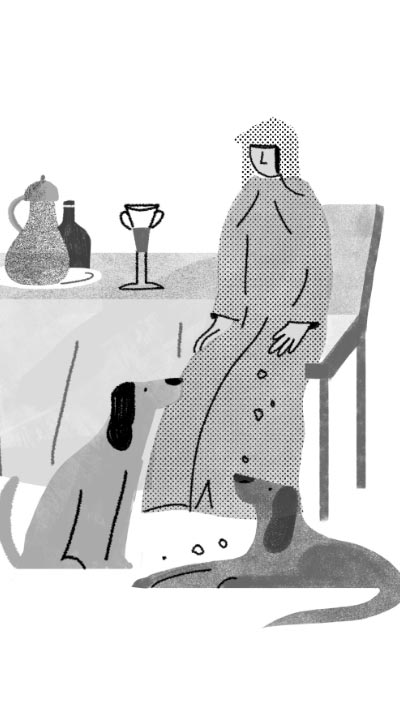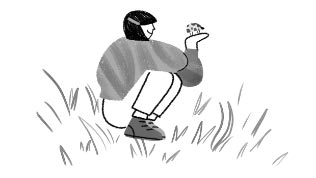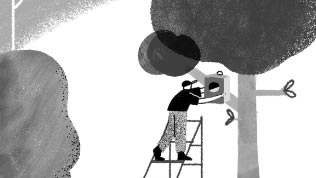For better or worse?
by Harriet Ritvo
Throughout history, human influence on animal lives has been inescapable - but for whose benefit?
Human history has always been entangled with that of other animals, even though the details of that entanglement are not always clear. Before we settled down, for example, we were both hunters and hunted. When archaeologists interpret the contents of caves containing human and non-human bones, they need to check the human bones for tooth marks as well as the non-human bones for signs of butchering. Similarly, there are conflicting theories about the earliest domestication. Did wolf-the-hunter decide to cooperate with man-the-hunter in the long pre-agricultural period? Or, somewhat later, did wolf-the-scavenger decide to endure (and subsequently enjoy) the companionship of people in order to eat their garbage? The second theory suggests that the domestication of the dog was similar to that of the cat, which will please some readers but not others.
The earliest relationship between humans and other animals - hunting - has continued into the present, although the motivation has become increasingly recreational rather than economic: for at least the last 10 millennia, domesticated ungulate species have provided more reliable and accessible sources of meat. As human populations grew, and human settlements and fields occupied more and more territory, there was less and less space for (and tolerance of) wild animals. In Britain, most of the larger wild animals had disappeared or retreated to sparsely settled areas by the end of the Middle Ages. Domesticated animals provided labour as well as sustenance; they offered entertainment, enlightenment and companionship. But, despite their various contributions to human economies and societies, for most of this long history of association there is little evidence of concern for the suffering of other animals, except to the extent that their incapacity due to injury or illness made them unable to perform essential services.
From a 21st-century perspective, it is hard to doubt that some of the people who have lived and worked closely with domesticated animals over the centuries enjoyed friendly, even affectionate, relations with them. Evidence for such relationships, though, is rather elusive, probably because pet-keeping, at least by people who did not belong to the highest social strata, invited disapproval as being frivolous or profligate. Even high status could not guarantee immunity. In The Canterbury tales, Geoffrey Chaucer implicitly criticised the indulgence and soft-heartedness of the prioress who kept 'smale houndes...that she fedde/With rosted flesh, or milk.../But sore weep she if oon of hem were deed'; she would even shed tears over a mouse caught in a trap. Almost four centuries later, in the 1780s, it was rumoured that Humphry Morice, a member of the privy council, had provided for his 30 aged horses and dogs, not in the main body of his will but in a codicil included in a letter to a friend, presumably because he feared posthumous ridicule (or worse).
Morice may have been unnecessarily apprehensive. By 1780, thinkers as diverse as Evangelical clergymen and the Utilitarian philosopher Jeremy Bentham had begun to argue for the humane treatment of animals. Despite the country's subsequent reputation as a nation of animal lovers, which developed in the 19th century, early humane advocates tended to characterise animals who lived in England as being especially subject to cruelty.
The initial attempts to create a legal basis for enforcing this emerging sensibility soon followed. In the first decade of the 19th century, Parliament failed to pass Bills to abolish bull-baiting and offer broader protection for livestock and pets; supporters of the moves to introduce them often encountered both derision and hostility. Legislative sentiment gradually changed, however. In 1821, when Richard Martin - who had voted in favour of the earlier unsuccessful Bills - introduced his 'Bill to prevent cruel and improper treatment of Cattle' (which included most farm and draft animals, but not bulls or pets), it was endorsed by both the clergy and the London magistrates. Many ordinary citizens signed supporting petitions. The Bill passed into law the following year.
The Society for the Prevention of Cruelty to Animals was founded in 1824 (Queen Victoria made it Royal in 1840) with a complex mission: to enforce the provisions of what was known as 'Martin's Act'; to advocate for its application to animals who did not fall under even its relatively broad definition of 'cattle'; and to encourage the spread of humane sympathies among the general public. Despite some financial and administrative difficulties in its earliest years, the Society soon began to attract widespread public support. In 1835, Parliament passed 'An Act to Consolidate and Amend the Several Laws Relating to the Cruel and Improper Treatment of Animals', extending the provisions of Martin's Act to domestic pets and prohibiting bull-baiting and cockfighting. Since the mere existence of a law does not necessarily guarantee that people will observe its provisions, the Society also established and maintained a group of inspectors, charged with its enforcement.
The concerns and achievements of the Society were recorded each year in its annual report. Each volume allotted many pages to a selection of the prosecutions carried out in the previous year. They were vividly described - a reminder to readers of the gravity of the offences - and almost all the cases chosen for inclusion had a successful outcome, at least in the sense that the human miscreant was convicted - the animal victim was often beyond help. Either the Society's secretary or one of the inspectors usually figured as a witness, which reminded supporters of the practical impact of their donations. Despite the 1835 (and later) expansions of the kinds of animals legally protected from abuse, most of the featured cases dealt with infractions that would have been covered under Martin's Act. These were also the kinds of abuses that were most apparent to the Society's inspectors, as well as to the general urban population. The streets of cities and towns were full of horses; the drivers of cabs and other conveyances often attempted to increase their speed by beating them - even though beating was unlikely to achieve much if the horse was overworked, undernourished or ill. In such cases, more extreme measures might be deployed, such as the fire lit by a Shadwell carter under the belly of a horse who could not drag a heavy cart up a hill. Equally conspicuous were the cattle, sheep and pigs who trudged through the streets on the final stage of their journey from farm to butcher or slaughterhouse. Like cab drivers, livestock drovers encouraged their charges with sticks and whips, even though, after their long walk, the animals were often weary and hobbled by injuries. A Wolverhampton pig drover, for example, was convicted of cruelly beating some pigs who fell down frequently because their feet were bleeding and, in some cases, their hoofs were 'only hanging on by a thin piece of skin', according to one Society report.
Dogs and cats accounted for only a small percentage of total prosecutions but received more than their fair share of attention in the annual reports. Pet-keeping became increasingly widespread in the 19th century, which also saw the emergence of such related institutions as breed societies, books of pedigrees and pet shows. Owners' attachment to their pets made it easy for them to sympathise with feline and canine victims, especially since their ill treatment didn't even have the weak economic rationalisations that might have motivated drivers and drovers to mistreat the animals they were responsible for. The Skye terrier who was doused with turpentine, then covered with straw and set on fire, or the cat whose nose was bitten off along with one of its teeth, were simply the victims of human malice. Even rarer and more compelling were the attempts to prevent public spectacles of animal combat. Accounts of these emphasised the perils routinely encountered by the inspectors, since patrons of dog fights or bull-baitings were likely to resent interference with their entertainment. Of course, the same was true of the armed abusers of horses and livestock, but inspectors usually only confronted one such individual at a time.
The perpetrators of most of these abuses tended to be working men. But that was not the case with activities such as the bull-runs, which people enjoyed as participants as well as observers. These could also be understood as traditional sports uniting (usually) men from all ranks of society. After the passage of the 1835 legislation, elite aficionados were occasionally prosecuted in connection with these offences. Such prosecutions could be embarrassing for the Society, but they also provided it with a response to occasional criticisms that its prosecutions showed class bias. Pursuits with a preponderance of middle- and upper-class participants posed a different set of issues. More radical groups objected to such pastimes as horse racing and fox hunting in terms that remain familiar, but these objections didn't attract much attention.
In the second half of the 19th century, the Society had to confront the use of animals in scientific experiments. The practice was not new, either for purposes of research or demonstration, but had mostly been associated with scientific practices on the Continent. As it gradually became clear that the most promising research was being pursued in the laboratories and on the operating tables of French and German physiologists, English scientists began to incorporate vivisection into their research and training. Sentiment was divided among Society members along lines that continue to characterise similar debates today. In 1874, the Society unsuccessfully prosecuted the French physiologist Eugene Magnan and three English doctors who had helped him experiment on a dog at the annual meeting of the British Medical Association. In 1876, John Colam, the Society's secretary, testified before the Royal Commission on the 'Practice of Subjecting Live Animals to Experiments for Scientific Purposes'. He recommended the prohibition of all painful experiments - and of all experiments, whether painful or not - undertaken simply for the purpose of training or demonstration. The Commission was more strongly influenced by the arguments of scientific practitioners, however, and the resulting Cruelty to Animals Act (1876) licensed experimentation on animals. While the Act introduced licences, inspections and restrictions on the purposes of animal experimentation, along with other regulations, committed antivivisectionists were disappointed.
In addition to prosecuting offences, reporting to members, and representing members' views to policymakers, the Society reached out to a broader public. Beginning in 1869, it published The animal world: A monthly advocate of humanity, an illustrated periodical that emphasised the positive side of the Society's mission. It did include accounts of cruelty to animals, but descriptions of harmonious relationships with animals were more prominent, and its messages were conveyed through fiction and poetry as well as essays and news items. The illustrations echoed the positive tone. For example, the lead article of one Christmas number, entitled 'The royal dumb favourites at Balmoral', featured an engraving of Queen Victoria and Princess Beatrice surrounded by four of their 'faithful [canine] friends'. Each issue was headed by a quotation from 'The rime of the ancient mariner' by Samuel Taylor Coleridge:
He prayeth well who loveth well,
Both man, and bird, and beast;
He prayeth best who loveth best,
All things, both great and small;
For the dear God who loveth us,
He made and loveth all.
Coleridge wrote those lines near the end of the 18th century, decades before humane advocacy gathered strength enough to influence legislative action. That they remained resonant after almost three-quarters of a century shows the persistence of several complementary strains within the animal protection movement: the focused attention to specific abuses embodied in Martin's Act, the legislation that followed it and a more holistic sense of kinship with members of other animal species.

Harriet Ritvo
Harriet Ritvo is Arthur J Conner Professor of History Emeritus at the Massachusetts Institute of Technology. She has written widely about the history of human relations with other animals, especially in Britain and the British Empire. Her books include The animal estate, The platypus and the mermaid and other figments of the classifying imagination and Noble cows and hybrid zebras.



